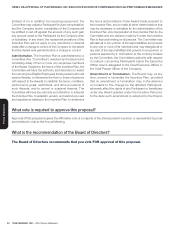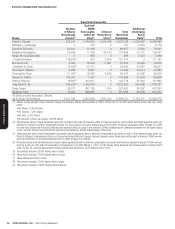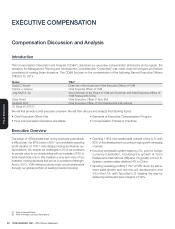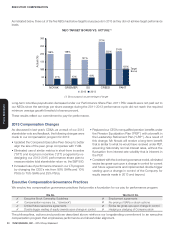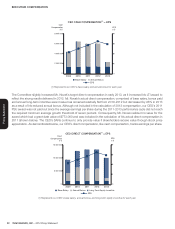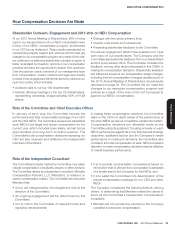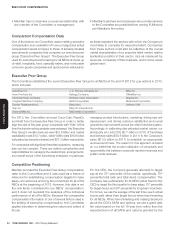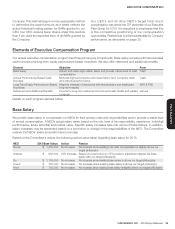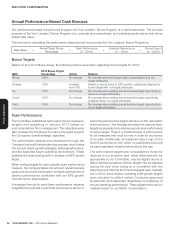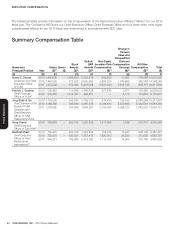Pizza Hut 2013 Annual Report Download - page 56
Download and view the complete annual report
Please find page 56 of the 2013 Pizza Hut annual report below. You can navigate through the pages in the report by either clicking on the pages listed below, or by using the keyword search tool below to find specific information within the annual report.
YUM! BRANDS, INC.-2014Proxy Statement34
Proxy Statement
EXECUTIVE COMPENSATION
•
Meridian has no business or personal relationship with
any member of the Committee or management.
•
Meridian’s partners and employees who provide services
to the Committee are prohibited from owning YUM stock
per Meridian’s firm policy.
Comparator Compensation Data
One of the factors our Committee uses in setting executive
compensation is an evaluation of how our target and actual
compensation levels compare to those of similarly situated
executives at companies that comprise our executive peer
group (“Executive Peer Group”). The Executive Peer Group
used for executive benchmarking for all NEOs is made up
of retail, hospitality, food, specialty eatery, and nondurable
consumer goods companies and quick service restaurants,
as these represent the sectors with which the Company is
most likely to compete for executive talent. Companies
from these sectors must also be reflective of the overall
market characteristics of our executive talent market, relative
leadership position in their sector, size as measured by
revenues, complexity of their business, and in some cases
global reach.
Executive Peer Group
The Committee established the current Executive Peer Group for all NEOs at the end of 2012 for pay actions in 2013,
which includes:
AutoZone Inc. J. C. Penney Company Inc. Nike Inc.
Avon Products Inc. Kellogg Company OfficeMax Inc.
Campbell Soup Company Kimberly-Clark Corporation Staples Inc.
Colgate Palmolive Company Kohl’s Corporation Starbucks Corporation
Darden Restaurants Inc. Macy’s Inc. Unilever USA
Gap Inc. Marriott International
General Mills Inc. McDonald’s Corporation
For 2013, the Committee removed Coca-Cola, PepsiCo
and Kraft from the Executive Peer Group in order to better
align the size of the peer group companies with YUM. At the
time the benchmarking analysis was prepared, the Executive
Peer Group’s median revenues were $15.6 billion and market
capitalization was $12.7 billion, while YUM’s were $18.6 billion
(calculated as described below) and $27.2 billion respectively.
For companies with significant franchise operations, measuring
size can be complex. There are added complexities and
responsibilities for managing the relationships, arrangements,
and overall scope of the franchising enterprise, in particular,
managing product introductions, marketing, driving new unit
development, and driving customer satisfaction and overall
operations improvements across the entire franchise system.
Accordingly, in calibrating size-adjusted market values, our
philosophy is to add 25% ($7.7 billion in 2011) of franchisee
and licensee sales ($30.6 billion in 2011) to the Company’s
sales ($10.9 billion in 2011) to establish an appropriate
revenue benchmark. The reason for this approach is based
on our belief that the correct calibration of complexity and
responsibility lies between corporate-reported revenues and
system widerevenues.
Competitive Positioning
Meridian provided the Executive Peer Group compensation
data to the Committee and it was used as a frame of
reference for establishing compensation targets for base
salary, annual bonus and long-term incentives for all of the
NEOs at the beginning of 2013. However, this data is not
the only factor considered for our NEOs’ compensation,
and it does not supplant the analyses of the individual
performance of all of the NEOs. Because the comparative
compensation information is one of several factors used in
the setting of executive compensation, the Committee
applies discretion in determining the nature and extent of
its use.
For the CEO, the Company generally attempts to target
pay at the 75th percentile of the market, specifically, 75th
percentile total cash and total direct compensation. The
Company has a philosophy for its NEOs (other than for the
CEO) to target the third quartile for base salary, 75th percentile
for target bonus and 50
th
percentile for long-term incentives.
For bonus, we use the average of the last three year’s actual
bonus paid rather than target bonus when benchmarking
for all NEOs. When benchmarking and making decisions
about the CEO’s SARs and options, we use a grant date
fair value based on the full 10-year term rather than the
expected term of all SARs and options granted by the


